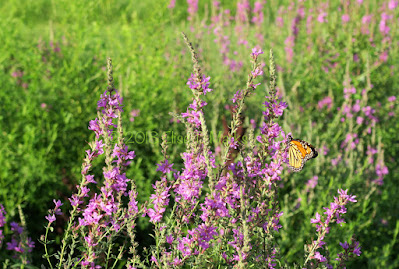Danaus plexippus on Echinacea purpurea.
The entire plant can be used for its immune boosting properties. The purple ray flowers attach to a round, high and spiky cone, hence the common name, purple coneflower. Technically speaking, this thick and spiky cone is actually hundreds of flowers, all tightly packed together. Echinacea's name is rooted in the Greek word “echinos,” meaning "hedgehog," because of its spiny seed head.
On Milkweed.
Which end is which on this Monarch Caterpillar On Milkweed. Monarchs can’t survive without milkweed. They need it to lay their eggs on and their caterpillars only eat milkweed plants. The monarch butterfly population is in danger because milkweed plants are disappearing, due to loss of habitat stemming from land development and the widespread spraying of weed killer on the fields where they live. We can help monarchs by growing milkweed in our yards, fields, and gardens.
Monarch Butterfly On Purple Loosetrife
They say that the name Butterfly is of unknown origin, but I believe that they were originally called Flutterbys, as I like to call them, and that someone (perhaps a child), probably mispronounced it, and it stuck. They are fascinating creatures who take to the air on gossamer wings. They've come to symbolize metamorphosis. These remarkable pollinators display a diversity of colors and patterns.
Monarchs can’t survive without milkweed. They need it to lay their eggs on and their caterpillars only eat milkweed plants. The monarch butterfly population is in danger because milkweed plants are disappearing, due to loss of habitat stemming from land development and the widespread spraying of weed killer on the fields where they live. We can help monarchs by growing milkweed in our yards, fields, and gardens.
Danaus plexippus on Asclepias tuberosa, a species of milkweed native to eastern North America.

(Danaus plexippus) on purple cone flower.
Monarch Butterfly On Echinacea, From A Different Angle
This photo was Awarded Capture My Vermont, Photo of the Day, for August 17, 2018.
(aka floss flower, bluemink, blueweed, pussy foot, Mexican paintbrush) The easiest way to tell a male monarch butterfly from a female monarch is by looking for two dark spots on the hindwings—the female butterflies don’t have these spots. A female monarch in the wild can lay up to 500 eggs on milkweed plants throughout her lifetime. The adult monarchs you see fluttering through your backyard when the weather’s warm typically live only about 4 or 5 weeks — just long enough to mate and produce the next group. It takes four generations of monarchs to complete their annual migration journey before ending up in your garden again. However, the fourth “super generation” that overwinters in Mexico can live for as long as eight months. Monarch butterflies can flap their wings up to 12 times a second when flying at their fastest. Monarch butterflies fly a long distance during fall migration, farther than any other tropical butterfly—up to 3,000 miles.
Monarch Butterfly On Purple Vervain
The purpletop vervain or Verbena bonariensis is a perennial originating from South America, but in our latitudes it is not sufficiently hardy and therefore rather short-lived. Therefore it is often used as a summer flower – even though it can grow in the garden for years by self-sowing. Its flowers attract over 40 different species of butterflies!

















































































